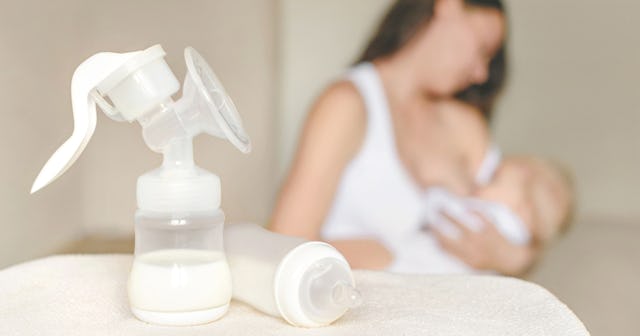How To Use A Manual Breast Pump — And Why This Little Gem Is A Smart Buy

One of the hardest things about the early days of motherhood (and goodness knows there are a lot of them) is figuring out your breastfeeding schedule and whether or not you want to do it in the first place. As you’ve likely heard before, breastfeeding is a highly personal decision, and it’s made even more complicated when you want to breastfeed but are having trouble producing milk or letting it down with your electric breast pump. The good news is that you have options aside from giving up entirely. First up? Learning how to use a manual breast pump.
Interesting fact: Some women, per Coffee and Coos, find that they get better output when using a manual breast pump (more on that in a minute). And that’s not the only pro associated with the manual breast pump. For one, it costs way less than the electric ones, and of course, all you need to make it function is your hand. So, bonus, you don’t have to run around looking for an outlet and end up sitting in a back corner of some stadium while everyone else enjoys a game or concert.
If anything, learning how to use a manual breast pump is just a good idea so that you have options on top of your electric pump. If you love your electric one, go ahead and keep it! But tossing a manual breast pump into your diaper bag makes sense in case of emergency, even if you end up not using it all the time.
Polly Kocher, an international board-certified lactation consultant who works at the OSF Breastfeeding Resource Center at OSF Saint Francis Medical Center in Peoria, Illinois, might have put it best when she told Parents magazine how to decide which breast pump is right for you. She advised, “I say, ‘Do you cut up your own carrots, or do you buy the little ones already cut up?’ Think about what your personality is and how much process you want to put into something. If you thrive off efficiency and time-saving techniques, an electric breast pump may be right for you. But if you don’t mind a little extra work —and if you’re breastfeeding only occasionally — a manual breast pump is probably your best bet.”
Do you get more milk with a manual pump?
You may have seen talk on the mommy forums about how some moms prefer manual breast pumps because they get a greater milk output. Is this true? First, remember that — as with all parenting-related things — everyone’s experience is different. Some moms do, indeed, swear by manual pumps and their perceived ability to eke out more breastmilk. The prevailing theory seems to be that you’re more in control of the positioning and speed of the pumping with manual breast pumps, and therefore you can make adjustments until you hit optimal output.
However, you could read 100 comments from other moms touting the manual pump’s proficiency and fail to see the same results. Your breasts may not respond to a manual pump as well. Or perhaps you can’t seem to find the right method. Bottom line: Do what works for you, Mama.
How long should I pump with a manual pump?
Everyone should consult with their own doctor and resources to find a breastfeeding schedule that works for them. If you’re exclusively pumping, investing in an electric pump might sound like the best idea, but really, a manual breast pump shouldn’t take that much longer.
You should budget about 15 to 20 minutes per breast using a manual pump to get a decent amount of milk, although it may take longer. While electric pumps will allow you to pump both breasts simultaneously, there’s no reason not to have a manual pump in each hand to speed up the process if you get good at using this type of pump.
How do you use a manual breast pump?
It’s actually quite simple to use a manual breast pump. Per Healthline Parenthood, here are the basic steps to follow with your manual breast pump:
- Make sure your hands and the pump are totally clean.
- Begin by hand expressing, which means massaging the breast in a pumping motion, so you’re squeezing the breast and pulling it out before releasing it.
- Once you feel like your breasts are stimulated, you put one nipple inside the pump’s flange and put it flat on your breast.
- Then, pump the manual breast pump handle.
- You can repeat these steps on your other breast and switch it between them as much as you want to keep the flow going.
- Once you feel like you have most of the milk drained, you can hand express to finish properly.
And voila! You’ve successfully used your manual breast pump. It’s not as complicated as it looks, right?
Manual vs. Electric Breast Pump
Each woman is different, and some pumps may work better for them than others. So, if you’re deciding between a manual and electronic model, here are a few things to consider. Manual pumps are usually less expensive than electronic ones. They’re also way easier to tuck away and store. Manual models don’t make as much noise as an electronic one, but automated pumps do the work for you.
Manual breast pumps could require you to pump with your hand for about ten to 15 minutes. However, an electronic breast pump is a bit faster than a manual one. This helps you express more milk and works well for moms who work and don’t have a lot of time. When manually pumping, it could take about 20 to 30 minutes to pump each breast.
This article was originally published on